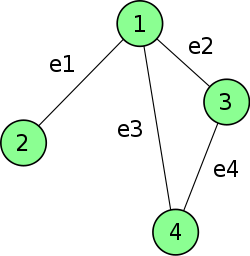- Incidence matrix
-
In mathematics, an incidence matrix is a matrix that shows the relationship between two classes of objects. If the first class is X and the second is Y, the matrix has one row for each element of X and one column for each element of Y. The entry in row x and column y is 1 if x and y are related (called incident in this context) and 0 if they are not. There are variations; see below.
Contents
Graph theory
Incidence matrices are mostly used in graph theory.
Undirected and directed graphs
In graph theory an undirected graph G has two kinds of incidence matrices: unoriented and oriented. The incidence matrix (or unoriented incidence matrix) of G is a p × q matrix (bij), where p and q are the numbers of vertices and edges respectively, such that bij = 1 if the vertex vi and edge xj are incident and 0 otherwise.
For example the incidence matrix of the undirected graph shown on the right is a matrix consisting of 4 rows (corresponding to the four vertices, 1-4) and 4 columns (corresponding to the four edges, e1-e4):
The incidence matrix of a directed graph D is a p × q matrix [bij] where p and q are the number of vertices and edges respectively, such that bij = − 1 if the edge xj leaves vertex vi, 1 if it enters vertex vi and 0 otherwise. (Note that many authors use the opposite sign convention.)
An oriented incidence matrix of an undirected graph G is the incidence matrix, in the sense of directed graphs, of any orientation of G. That is, in the column of edge e, there is one +1 in the row corresponding to one vertex of e and one −1 in the row corresponding to the other vertex of e, and all other rows have 0. All oriented incidence matrices of G differ only by negating some set of columns. In many uses, this is an insignificant difference, so one can speak of the oriented incidence matrix, even though that is technically incorrect.
The oriented or unoriented incidence matrix of a graph G is related to the adjacency matrix of its line graph L(G) by the following theorem:
where A(L(G)) is the adjacency matrix of the line graph of G, B(G) is the incidence matrix, and Iq is the identity matrix of dimension q.
The Kirchhoff matrix is obtained from the oriented incidence matrix M(G) by the formula
- M(G)M(G)T.
The integral cycle space of a graph is equal to the null space of its oriented incidence matrix, viewed as a matrix over the integers or real or complex numbers. The binary cycle space is the null space of its oriented or unoriented incidence matrix, viewed as a matrix over the two-element field.
Signed and bidirected graphs
The incidence matrix of a signed graph is a generalization of the oriented incidence matrix. It is the incidence matrix of any bidirected graph that orients the given signed graph. The column of a positive edge has a +1 in the row corresponding to one endpoint and a −1 in the row corresponding to the other endpoint, just like an edge in an ordinary (unsigned) graph. The column of a negative edge has either a +1 or a −1 in both rows. The line graph and Kirchhoff matrix properties generalize to signed graphs.
Multigraphs
The definitions of incidence matrix apply to graphs with loops and multiple edges. The column of an oriented incidence matrix that corresponds to a loop is all zero, unless the graph is signed and the loop is negative; then the column is all zero except for ±2 in the row of its incident vertex.
Hypergraphs
Because the edges of ordinary graphs can only have two vertices (one at each end), the column of an incidence matrix for graphs can only have two non-zero entries. By contrast, a hypergraph can have multiple vertices assigned to one edge; thus, the general case describes a hypergraph.
Incidence structures
The incidence matrix of an incidence structure C is a p × q matrix [bij], where p and q are the number of points and lines respectively, such that bij = 1 if the point pi and line Lj are incident and 0 otherwise. In this case the incidence matrix is also a biadjacency matrix of the Levi graph of the structure. As there is a hypergraph for every Levi graph, and vice-versa, the incidence matrix of an incidence structure describes a hypergraph.
Finite geometries
An important example is a finite geometry. For instance, in a finite plane, X is the set of points and Y is the set of lines. In a finite geometry of higher dimension, X could be the set of points and Y could be the set of subspaces of dimension one less than the dimension of Y; or X could be the set of all subspaces of one dimension d and Y the set of all subspaces of another dimension e.
Block designs
Another example is a block design. Here X is a finite set of "points" and Y is a class of subsets of X, called "blocks", subject to rules that depend on the type of design. The incidence matrix is an important tool in the theory of block designs. For instance, it is used to prove the fundamental theorem of symmetric 2-designs, that the number of blocks equals the number of points.
References
- Diestel, Reinhard (2005), Graph Theory, Graduate Texts in Mathematics, 173 (3rd ed.), Springer-Verlag, ISBN 3-540-26183-4.
- Coxeter, H.S.M. Regular Polytopes, (3rd edition, 1973), Dover edition, ISBN 0-486-61480-8 (Section 9.2 Incidence matrices, pp. 166-171)
- Jonathan L Gross, Jay Yellen, Graph Theory and its applications, second edition, 2006 (p 97, Incidence Matrices for unidrect graphs; p 98, incidence matrices for digraphs)
- Weisstein, Eric W., "Incidence matrix" from MathWorld.
Categories:- Algebraic graph theory
- Combinatorics
- Matrices
- Graph data structures
Wikimedia Foundation. 2010.



